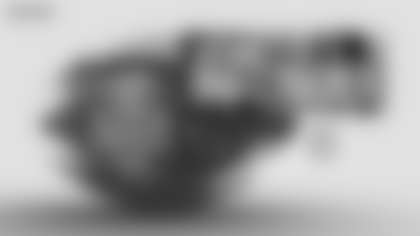This hit by Browns running back Trent Richardson on Eagles safety Kurt Coleman last season was one of the main examples the NFL used in creating and then passing the new rule of not using the crown of your helmet.
When an offensive player gets into the open field and that instinct to bulldoze through a defender head-first kicks in, they'll have to think twice about it now.
The NFL outlawed a player, offense or defense, from using the crown of their helmet to initiate contact in a 31-1 vote on Wednesday morning. It was one of six rule proposals passed at the league's owners meetings at the Arizona Biltmore. The other five ranged from the minute, such as adding more jersey numbers for halfbacks and tight ends to the touchy, eliminating the tuck rule.
But the crown rule was the most hotly discussed at the three-day meetings.
The league reviewed every play from Weeks 10 and 16 of the 2012 season and discovered 11 helmet-to-helmet plays that would've been illegal under the newly adopted legislation. That doesn't sit well with some coaches and running backs.
"I'm just anxious to see how they're going to officiate the whole thing," Cardinals running back Ryan Williams said. "I don't really know statistically how many defensive players have been hurt by running backs."
While the NFL didn't have any data on injuries from helmet-to-helmet hits, Williams felt the rule will take away a player's instincts to protect themselves and the football. When a runner drops his shoulder to brace for a hit, the head naturally comes down, which leads to the majority of helmet-to-helmet hits. Throughout the league, there has been a growing concern about what will be considered legal and what would be flagged.
St. Louis Rams coach Jeff Fisher, a member of the competition committee, dissected the helmet into four segments: facemask, hairline/forehead, sides and the crown. Any hit on the first three areas are legal but once a player uses the crown of his helmet, they will be flagged, Fisher said.
"We're bringing the shoulder back to the game," Fisher said.
Cardinals coach Bruce Arians said he doesn't want his running backs to think about what part of their helmet to use while they're playing.
"You got to play the way you know how to play," Arians said. "I don't want any back running the football and thinking he's going to get hurt because the other 10, 11 guys are coming to hurt him and hit him real hard.
"So you protect yourself and when you lower your shoulder and depending on the flexibility of your neck is how high you can get your head. The only problem I have with the rule is putting it in the hands of the officials is (choosing) who ducked their head."
Williams doesn't remember using the crown of his head intentionally and is "pretty sure" he's been hit with the crown before. While he appreciates the league keeping playing safety in mind, the third-year running back is worried players will soon be scared to hit each other.
"I'm not in favor of the rule just for the simple fact that I think they're taking away instincts of running backs," Williams said. "But if both of y'all are aware of what you're about to do there shouldn't be no call.
"In a couple of years it's going to be a professional flag-football game."
Fisher, Atlanta Falcons President Rich McKay and NFL Vice President of Officiating Dean Blandino said the play would have to be an obvious and clear use of the crown to initiate contact. The officials would be allowed to huddle and discuss the play before moving forward with a penalty, if required.
The details of the rule require the play to happen outside the tackle box – from left tackle to right tackle, and from three yards into the defensive side of the ball back to the goal line behind the offense – and a player has to square up to his opponent, line up his shoulders and use the very top of his helmet. The penalty will be a 15-yard spot foul. If the defense is flagged, it will be a 15-yard penalty from the spot of the foul or end of the run, whichever is further down field, and a first down. If the offense is flagged, the penalty will be stepped off 15 yards from the spot of the foul.
Fines that may accompany the penalty will be from the same fine schedule as defenseless receiver penalties.
The Cincinnati Bengals were the lone dissenting team.
Pittsburgh Steelers President Art Rooney II said the discussions about the rule included changing the yardage penalized and fining players instead of penalizing either or both sides.
Neither of those ideas gained any traction.
While player safety is at the root of the rule, and most coaches and players agree with that, the way the rule is to be officiated sparked fierce emotion from all parties involved.
"Anytime we have a rule change, how it's officiated is a big topic," Dallas Cowboys owner Jerry Jones said. "It was discussed for the last several months and we feel that our officials can get a handle on it. They certainly do, and we do too that they can make as good as calls as we should expect, our fans should expect.
"But it'll certainly make our runners aware of what we expect relative to the use of the helmet. And one of the questions I ask a lot is who gains from this, offense or defense? Which side of the ball has the advantage in this rule, if any. The main thing is it's pro-health and safety and that's a big thing."
Other rules passed Wednesday by the owners:
- Challenge rule: A team will be charged a 15-yard penalty if it is out of challenges and/or timeouts.
- PAT/FG rush: Teams cannot line up more than six players on either side of the center. Illegal formation will be loss of five yards from previous spot. Unnecessary roughness will be loss of 15 yards from previous spot.
- Tuck rule change: If a quarterback loses the ball during an intentional forward movement, it is a fumble, not an incomplete pass.
- TE/HB numbers: Tight ends and halfbacks will be allowed to also wear numbers 40-49.
- Peel-back block: A defender cannot initiate contact from the back or side if a blocker is facing his own goal line.
- One rule that was passed in 2012 and will be enforced starting in the preseason will require players to wear thigh and knee pads. A league official will patrol the sidelines checking uniforms. If a player isn't compliant, he'll be asked to comply. If he doesn't, the league official can keep him off the field until he wears the required padding. "You better have them on," Arians said. "I think it's a good rule. I think with the materials that are out today you wouldn't know you had them on. I've always wondered why guys don't wear them now. When we go in pads I'll make sure everyone wears everything that they have to wear in games so we're used to it."














